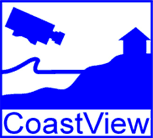CoastView project

Video monitoring of littoral processes in support of coastal-zone management.
Why is a European Scale Project Required? A central theme (WP1) of the CoastView project is the development of a set of simplified Coastal State Indicators (CSIs). These are defined as, 'a minimum set of parameters that can simply, adequately & quantitatively describe the dynamic-state of a coastal system'. The focus of the project will be to derive generic and environment specific CSIs that can be monitored using purpose-designed, cost-effective video techniques. The definition of these video-based CSIs can only be achieved within the framework of a European project for the following reasons:
- The need for a generic set of CSIs necessitates sampling in a range of physically different environments that typify European coastlines. This project includes coastal areas in the North Sea, English Channel, Atlantic Ocean and Mediterranean Sea. Each of these sites has very different wave climate, tidal regime, sediment type and morphology. Thus, in order to derive a set of generic CSIs that are appropriate to the whole Community we must include a minimum representative sub-set of European coastal environments. Generic CSIs will be developed and tested at each of these sites.
- We also recognise the need for certain environment specific CSIs, which also necessitates measurements at a range of different types of coastline. Generally this would beyond the scope of a national-scale project. Four field sites have been prioritised for study in the CoastView Project in order to cover the typical types of European coastline and their associated management problems.
These include:
- A continuous beach that is subject to shoreface renourishment, (Egmond, The Netherlands).
- A continuous beach protected for part of its length by offshore submerged-breakwaters, (Lido Di Dante, Italy).
- A coastal estuarine navigation channel subject to regular dredging, (El Puntal, Spain)
- A navigable estuary mouth with multiple, highly mobile sandbanks, (Teignmouth, UK).
These sites have been selected specifically for the following reasons: We require CSIs that are appropriate for both undefended coastlines with a soft engineering policy (Egmond) and coastlines defended by hard engineering (Lido Di Dante). These sites will yield CSIs that indicate the evolving state of these environments as well as the effectiveness and dispersion of beach nourishment and the stability and environmental impact of coastal structures. The third environmental category selected for study within CoastView is coastal inlets.
- The European dimension of this project brings together coastal managers and scientist from all over Europe. The consortium includes national scale coastal managers from Spain, Italy, the Netherlands and the United Kingdom (associated with each of the field sites) as well as scientists from six countries. Each country has slightly different management policies and implementation practices. A project of this kind allows an effective cross-fertilisation of best practice derived from a variety of European sources, and the development of video derived CSIs that may be applied universally around European Coastlines. This approach complements the EU strategy for a progression towards standardisation for coastal zone management. The alternative sum of national efforts in this direction would inevitably provide a less effective piecemeal approach to the problem with no generic value. It should also be noted that a reduction in the number of field sites would severely reduce the value of the CSIs derived from this research by reducing both the number of environment-specific CSIs generated, and the number of international scale end-users involved in the project.
Research tasks
The work of the University of Ferrara will concentrate on the unprotected shore south of Lido di Dante (Ravenna, Italy). UF will assess the morphodynamic behaviour of the beach in natural conditions and compare it with the behaviour of the beach protected by the submerged breakwater, studied by the University of Bologna. One of the cameras installed on the tower built by the Regione Emilia will be provided with zoom capabilities to monitor beach behaviour to obtain information on the location of the inner bar, bathymetric variations between the bar and the foreshore, wave dissipation and shoreline. A permanent measuring station will be installed between the bar and the foreshore to provide information on wave characteristics, longshore and cross-shore current components. A 4-week campaign will be undertaken on the second year of the project, to obtain high frequency measurements of physical parameters, in order to accurately quantify wave dissipation across the bar-trough transition. During the field experiment offshore of the bar the RUNTI (Remote Unit for Nearshore Transport Investigation) benthic lander will be deployed to measure waves, currents and sediment resuspension at 0.5 m above the bed. A rig will be installed on the foreshore to obtain information on swash characteristics. Bathymetric surveys will be undertaken every six month in parallel with those carried out by the University of Bologna on the protected beach, to compare beach behaviour. A small boat will be maintained on site to survey the beach at higher frequencies (e.g. monthly), in order to assess the impact of particular storm events. During each survey, an accurate determination of the shoreline position will be done using cinematic GPS techniques (Dynamic Method). The obtained shoreline will be compared to that obtained from Argus measurements to evaluate errors in the remote technique. During each main topographic and bathymetric survey (e.g. every six months), the dune base, the foreshore and the trough-bar transition will be sampled to assess seasonal and short-term grain size variations. The sedimentological information will be integrated with the profile data to obtain morphodynamic models of beach variability.

